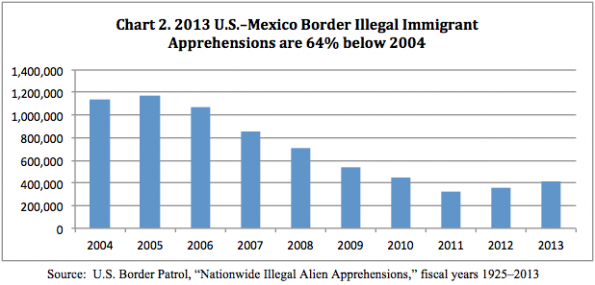On the cable news shows this last summer, you may have seen that our country is facing a “flood,” “surge,” or “deluge” of undocumented immigrants. Setting aside this problematic imagery, border data tells a wildly different story. In fact, according to researchers at Rice University’s Baker Institute for Public Policy, the overall rate of illegal immigration is incredibly low—in 2013, the number of people apprehended at the United States-Mexico border was 64 percent less than 2004. Preliminary estimates for 2014 show that the total for this year will also fall far below the number of apprehensions a decade ago.
In 2013, the number of people apprehended at the United States-Mexico border was 64 percent less than 2004.
Tony Payan, co-author on the report and expert on border studies, is quick to point out that the “humanitarian crisis” of unaccompanied children at the border was very real (though slowly waning now). Earlier this year, Border Patrol was catching so many kids that their detention facilities were overwhelmed and the children were living in squalid conditions. “The panic began because of the story of how these kids were housed,” Payan says. “The story ballooned and gave the impression that there is a huge immigration crisis.”
Panic about this supposed “flood” of undocumented immigrants led to an oversimplification of the state of illegal immigration in the U.S., Payan says. This notion creates the false sense of a general immigration crisis, one that demands more investment in protecting the border. In reality, illegal immigration has decreased considerably in the last decade, reaching a low point in 2011 and then growing at a much slower rate through 2013.

(Chart: Baker Institute for Public Policy)
Payan stresses that the decision to move to a different country is very complex, and people consider both the “push and pull” factors of their countries of origin and of their destination. During the period before 2011, the “pull” factors of the U.S. were decreasing, and for some countries, like Mexico, the “push” factors were also decreasing. First, the number of U.S. Border Patrol agents nearly doubled between 2004 and 2013, from 9,506 to 18,611. Previous research shows that “increases in the number of border enforcement personnel reduces undocumented immigration,” since potential immigrants know it will be much more difficult to cross unnoticed. Additionally, during the recession, unemployment was high and work was difficult to find in the U.S. Meanwhile, the manufacturing economy in Mexico was doing pretty well. Fewer Mexicans attempted a border crossing, Payan says, because of these factors.
So what would lead to the 26 percent increase between 2011 and 2013 in the graph above? “I personally think we’re not looking at more migrants attempting to cross. We’re looking at a much better ability of Border Patrol to catch those trying to cross,” Payan says. “Now you have more agents and resources to catch only a third of those that they were trying to catch back 10 years ago.”
The focused media attention on the recent spike of unaccompanied child immigrants is a distraction from the realities of our nation’s immigration system.
Much of recent illegal immigration has been concentrated in a relatively small southern section of Texas, near the Rio Grande Valley, which is another reason why the increase seems so anecdotally dire. Meanwhile, illegal immigration across other parts of the U.S.-Mexico border are holding steady or decreasing.
While it’s true that the number of unaccompanied child immigrants from Central America has increased in the past year or so, Payan stresses that the publicly available data from U.S. Border Patrol only goes back to 2010. The data for undocumented child immigrants (accompanied or otherwise) extends further back, and preliminary data “suggest that these apprehensions [of undocumented immigrants] have remained below levels a decade earlier,” much like overall apprehension numbers, according to the paper.
The focused media attention on the recent spike of unaccompanied child immigrants, then, is a distraction from the realities of our nation’s immigration system, Payan says. “Congress and the president could react and throw their hands up in the air and say that we need to seal the border—and that’s not what we need,” he says.
Instead of facing a crisis, the country may in fact have a unique opportunity, Payan says. Considering that the population of undocumented immigrants living in the U.S. has decreased in recent years, and illegal immigration is relatively low, the time is right to reform the immigration system, Payan says. “It’s time for Congress to understand that they … have a problem that’s actually easier than it used to be…. The problem is more manageable both inside the U.S. and at the border, and therefore they should not feel overwhelmed by the problem.”
A border expert can dream, can’t he?





